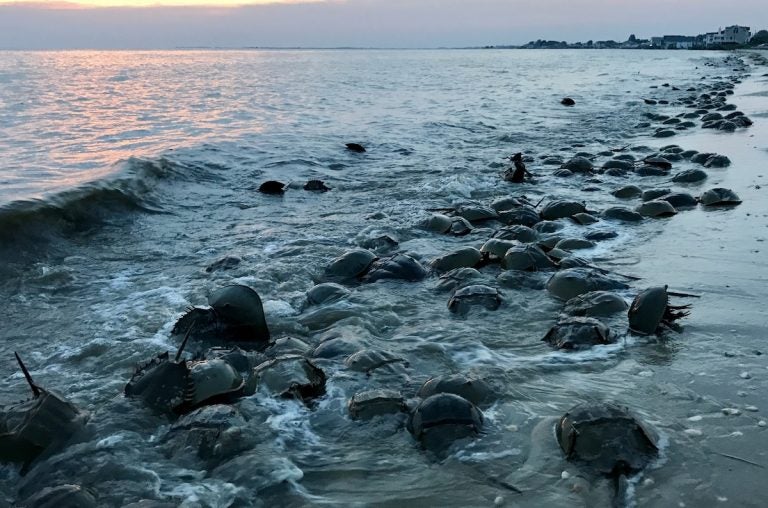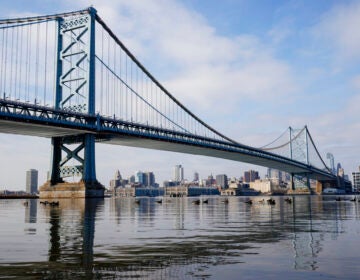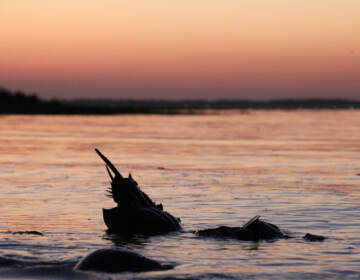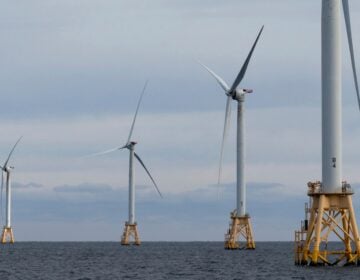‘Living fossils’: Horseshoe crabs survived several mass extinctions but may now need federal protections
Environmental groups want NOAA to protect horseshoe crab habitats, and restrict how the species are harvested.
Listen 1:20
When the spring high tides strike, tens of thousands of horseshoe crabs descend on the Delaware Bay to spawn. (Steph Yin/WHYY)
From Philly and the Pa. suburbs to South Jersey and Delaware, what would you like WHYY News to cover? Let us know!
Endangered red knot birds travel 9,000 miles each year from South America to the Arctic, making a stop at the Delaware Bay to rest and refuel on horseshoe crab eggs.
However, the bird’s food source was drastically reduced in the 1990s. That’s partly because fishers overharvested horseshoe crabs, which are used as bait for eel and whelk.
Horseshoe crabs also are harvested for their bright blue blood, which helps test the sterility of vaccines and other biomedical devices.
Horseshoe crabs have lived on Earth for at least 445 million years, which means they have survived several mass extinctions. But today, environmental groups say their populations have declined so much, they need federal protections to survive new threats. The Center for Biological Diversity and 22 other conservation organizations have petitioned NOAA to place them on the endangered species list to protect their habitats, and restrict how they’re harvested.
“We hope that it would lead to some significant changes in those harvest limits, if not an outright ban, or at least a moratorium on those harvests, until the horseshoe crabs can recover to more sustainable numbers,” said Will Harlan, a senior scientist with the Center for Biological Diversity.
New Jersey has a moratorium on harvesting horseshoe crabs for bait. However, the state allows the biomedical industry to use horseshoe crab blood for biomedicine.
It’s estimated that up to 1 million horseshoe crabs in the U.S. are harvested a year for the biomedical industry. Though horseshoe crabs are returned to the water after being bled by lab technicians, it is believed 15% to 30% of those eventually die.
While Delaware doesn’t have a biomedical fishery, the state does allow the harvesting of horseshoe crabs for commercial use.
Red knots declined about 75% from the 1980s to the 2000s, the U.S. Fish & Wildlife Service reports, largely because of reduced horseshoe crab eggs. Horseshoe crabs reached devastating lows in the 1990s because of overharvesting. Though harvesting restrictions have improved horseshoe crab populations, red knot numbers remain critically low, according to some surveys.
“We look to see how many horseshoe crab eggs are on the beaches of the Delaware Bay, and that really hasn’t recovered back to where it was before the overharvesting in the late 1990s,” said Tim Dillingham, executive director of the American Littoral Society, which has worked to conserve horseshoe crabs and red knots in New Jersey.
Since 2012, the Atlantic States Marine Fisheries Commission has recommended a male-only horseshoe crab harvest, using a scientific model (known as the ARM Framework) to calculate the amount of horseshoe crabs that can be harvested while still protecting red knots.
In 2022, the commission advanced a move to adopt a new framework for calculating quotas that utilizes data suggesting female harvests can be achieved while maintaining red knot health. The decision provoked public outcry from some scientists and environmentalists, who argued the commission isn’t taking poor egg density statistics into account.
In response to the backlash, the commission has continued recommending a male-only harvest. However, some environmentalists fear the commission could approve a female harvest in the future.
Dillingham said if the petition to NOAA is successful, harvesting may be prevented in some areas, and development and dredging might be restricted in areas where the crabs spawn.
He said he hopes listing the horseshoe crabs as endangered will help the red knots recover.
“We love the horseshoe crab because it’s an iconic species that is also a keystone species within the Delaware Bay ecosystem,” he said. “And keystone species means its life gives life to many other species.”
NOAA has up to 90 days to decide whether to accept the petition.

Get daily updates from WHYY News!
WHYY is your source for fact-based, in-depth journalism and information. As a nonprofit organization, we rely on financial support from readers like you. Please give today.







